staRdom: Versatile Software for Analyzing Spectroscopic Data of Dissolved Organic Matter in R
Abstract
1. Introduction
2. Materials and Methods
- Calculating fluorescence peaks and indices (tutorials S1 and S2) [47],
- Calculating common absorbance (slope) indices:
- ◦
- absorbance at 254 nm (a254) [43],
- ◦
- absorbance at 300 nm (a300) [50],
- ◦
- ratio of absorbance at 250 to 365 nm (E2:E3) [51],
- ◦
- ratio of absorbance at 465 to 665 nm (E4:E6) [52],
- ◦
- spectral slope within log-transformed absorption spectra range (S275–295, S350–400, S300–700) and the ratio of S275–295 to S350–400 (SR) [44],
- ◦
- the wavelength distribution of absorption spectral slopes [53] and
- ◦
- user-defined values and slopes can be extracted or calculated from the absorbance spectra.
2.1. Data Import
2.2. Data Preprocessing
2.3. PARAFAC Analysis
2.3.1. Calculation of a PARAFAC Model from EEM Data
2.3.2. Identification of Outliers
2.3.3. Model Evaluation
2.4. Export and Further Interpretation of Results
2.5. Toolbox Comparison
3. Results and Discussion
3.1. Number of Initializations
3.2. Convergence Criterion
3.3. Influence of Missing Data
3.4. Time until Model Convergence
3.5. Outlier Calculation and Split-Half Validation
4. Conclusions
Supplementary Materials
Author Contributions
Funding
Acknowledgments
Conflicts of Interest
Appendix A

References
- Findlay, S.; Sinsabaugh, R.L. Aquatic Ecosystems: Interactivity of Dissolved Organic Matter; Academic Press: Amsterdam, The Netherlands; Boston, MA, USA, 2003; ISBN 978-0-08-052754-3. [Google Scholar]
- Niño-García, J.P.; Ruiz-González, C.; del Giorgio, P.A. Interactions between hydrology and water chemistry shape bacterioplankton biogeography across boreal freshwater networks. ISME J. 2016, 10, 1755–1766. [Google Scholar] [CrossRef] [PubMed]
- Besemer, K.; Luef, B.; Preiner, S.; Eichberger, B.; Agis, M.; Peduzzi, P. Sources and composition of organic matter for bacterial growth in a large European river floodplain system (Danube, Austria). Org. Geochem. 2009, 40, 321–331. [Google Scholar] [CrossRef] [PubMed]
- Amaral, V.; Graeber, D.; Calliari, D.; Alonso, C. Strong linkages between DOM optical properties and main clades of aquatic bacteria. Limnol. Oceanogr. 2016, 61, 906–918. [Google Scholar] [CrossRef]
- Tranvik, L.J. Allochthonous dissolved organic matter as an energy source for pelagic bacteria and the concept of the microbial loop. In Dissolved Organic Matter in Lacustrine Ecosystems: Energy Source and System Regulator; Salonen, K., Kairesalo, T., Jones, R.I., Eds.; Developments in Hydrobiology; Springer Netherlands: Dordrecht, The Netherlands, 1992; pp. 107–114. ISBN 978-94-011-2474-4. [Google Scholar]
- Morris, D.P.; Zagarese, H.; Williamson, C.E.; Balseiro, E.G.; Hargreaves, B.R.; Modenutti, B.; Moeller, R.; Queimalinos, C. The attenuation of solar UV radiation in lakes and the role of dissolved organic carbon. Limnol. Oceanogr. 1995, 40, 1381–1391. [Google Scholar] [CrossRef]
- Fiedler, D.; Graeber, D.; Badrian, M.; Köhler, J. Growth response of four freshwater algal species to dissolved organic nitrogen of different concentration and complexity. Freshw. Biol. 2015, 60, 1613–1621. [Google Scholar] [CrossRef]
- Amon, R.M.W.; Benner, R. Bacterial utilization of different size classes of dissolved organic matter. Limnol. Oceanogr. 1996, 41, 41–51. [Google Scholar] [CrossRef]
- Benner, R.; Biddanda, B. Photochemical transformations of surface and deep marine dissolved organic matter: Effects on bacterial growth. Limnol. Oceanogr. 1998, 43, 1373–1378. [Google Scholar] [CrossRef]
- Benner, R. 5-Molecular Indicators of the Bioavailability of Dissolved Organic Matter. In Aquatic Ecosystems; Findlay, S.E.G., Sinsabaugh, R.L., Eds.; Aquatic Ecology; Academic Press: Burlington, ON, Canada, 2003; pp. 121–137. ISBN 978-0-12-256371-3. [Google Scholar]
- Babin, M.; Stramski, D.; Ferrari, G.M.; Claustre, H.; Bricaud, A.; Obolensky, G.; Hoepffner, N. Variations in the light absorption coefficients of phytoplankton, nonalgal particles, and dissolved organic matter in coastal waters around Europe. J. Geophys. Res. Oceans 2003, 108. [Google Scholar] [CrossRef]
- Taylor, P.G.; Townsend, A.R. Stoichiometric control of organic carbon–nitrate relationships from soils to the sea. Nature 2010, 464, 1178. [Google Scholar] [CrossRef] [PubMed]
- Wymore, A.S.; Coble, A.A.; Rodríguez-Cardona, B.; McDowell, W.H. Nitrate uptake across biomes and the influence of elemental stoichiometry: A new look at LINX II. Global Biogeochem. Cycles 2016, 30, 1183–1191. [Google Scholar] [CrossRef]
- Bejarano, A.C.; Chandler, G.T.; Decho, A.W. Influence of natural dissolved organic matter (DOM) on acute and chronic toxicity of the pesticides chlorothalonil, chlorpyrifos and fipronil on the meiobenthic estuarine copepod Amphiascus tenuiremis. J. Exp. Mar. Biol. Ecol. 2005, 321, 43–57. [Google Scholar] [CrossRef]
- Stedmon, C.A.; Markager, S.; Bro, R. Tracing dissolved organic matter in aquatic environments using a new approach to fluorescence spectroscopy. Mar. Chem. 2003, 82, 239–254. [Google Scholar] [CrossRef]
- Gabor, R.; Baker, A.; McKnight, D.M.; Miller, M. Fluorescence indices and their interpretation. In Aquatic Organic Matter Fluorescence; Cambridge Environmental Chemistry Series; Cambridge University Press: Cambridge, UK, 2014; pp. 303–338. [Google Scholar]
- Senesi, N.; Miano, T.M.; Provenzano, M.R. Fluorescence spectroscopy as a means of distinguishing fulvic and humic acids from dissolved and sedimentary aquatic sources and terrestrial sources. In Proceedings of the Humic Substances in the Aquatic and Terrestrial Environment, Linköping, Sweden, 21–23 August 1989; Allard, B., Borén, H., Grimvall, A., Eds.; Springer Berlin Heidelberg: Berlin/Heidelberg, Germany, 1991; pp. 63–73. [Google Scholar]
- Stubbins, A.; Lapierre, J.-F.; Berggren, M.; Prairie, Y.T.; Dittmar, T.; del Giorgio, P.A. What’s in an EEM? Molecular Signatures Associated with Dissolved Organic Fluorescence in Boreal Canada. Environ. Sci. Technol. 2014, 48, 10598–10606. [Google Scholar] [CrossRef] [PubMed]
- Herzsprung, P.; Osterloh, K.; von Tümpling, W.; Harir, M.; Hertkorn, N.; Schmitt-Kopplin, P.; Meissner, R.; Bernsdorf, S.; Friese, K. Differences in DOM of rewetted and natural peatlands - Results from high-field FT-ICR-MS and bulk optical parameters. Sci. Total Environ. 2017, 586, 770–781. [Google Scholar] [CrossRef] [PubMed]
- Graeber, D.; Boëchat, I.G.; Encina-Montoya, F.; Esse, C.; Gelbrecht, J.; Goyenola, G.; Gücker, B.; Heinz, M.; Kronvang, B.; Meerhoff, M.; et al. Global effects of agriculture on fluvial dissolved organic matter. Sci. Rep. 2015, 5, 16328. [Google Scholar] [CrossRef] [PubMed]
- Graeber, D.; Lorenz, S.; Poulsen, J.R.; Heinz, M.; von Schiller, D.; Gücker, B.; Gelbrecht, J.; Kronvang, B. Assessing net-uptake of nitrate and natural dissolved organic matter fractions in a revitalized lowland stream reach. Limnologica 2018, 68, 82–91. [Google Scholar] [CrossRef]
- McKnight, D.M.; Boyer, E.W.; Westerhoff, P.K.; Doran, P.T.; Kulbe, T.; Andersen, D.T. Spectrofluorometric characterization of dissolved organic matter for indication of precursor organic material and aromaticity. Limnol. Oceanogr. 2001, 46, 38–48. [Google Scholar] [CrossRef]
- Mopper, K.; Schultz, C.A. Fluorescence as a possible tool for studying the nature and water column distribution of DOC components. Mar. Chem. 1993, 41, 229–238. [Google Scholar] [CrossRef]
- Pullin, M.J.; Cabaniss, S.E. Physicochemical variations in DOM-synchronous fluorescence: Implications for mixing studies. Limnol. Oceanogr. 1997, 42, 1766–1773. [Google Scholar] [CrossRef][Green Version]
- Weishaar, J.L.; Aiken, G.R.; Bergamaschi, B.A.; Fram, M.S.; Fujii, R.; Mopper, K. Evaluation of Specific Ultraviolet Absorbance as an Indicator of the Chemical Composition and Reactivity of Dissolved Organic Carbon. Environ. Sci. Technol. 2003, 37, 4702–4708. [Google Scholar] [CrossRef] [PubMed]
- Spencer, R.G.M.; Aiken, G.R.; Butler, K.D.; Dornblaser, M.M.; Striegl, R.G.; Hernes, P.J. Utilizing chromophoric dissolved organic matter measurements to derive export and reactivity of dissolved organic carbon exported to the Arctic Ocean: A case study of the Yukon River, Alaska. Geophys. Res. Lett. 2009, 36. [Google Scholar] [CrossRef]
- Reynolds, D.M. The principles of fluorescence. In Aquatic organic matter fluorescence; Cambridge Environmental Chemistry Series; Cambridge University Press: Cambridge, UK, 2014; pp. 3–34. [Google Scholar]
- Warner, I.M.; Patonay, G.; Thomas, M.P. Multidimensional Luminescence Measurements. Anal. Chem. 1985, 57, 463A–483A. [Google Scholar] [CrossRef]
- Harshman, R.A. Foundations of the parafac procedure: Models and conditions for an “explanatory” multimodal factor analysis. UCLA Work. Pap. Phon. 1970, 16, 1–84. [Google Scholar]
- Carroll, J.D.; Chang, J.-J. Analysis of individual differences in multidimensional scaling via an n-way generalization of “Eckart-Young” decomposition. Psychometrika 1970, 35, 283–319. [Google Scholar] [CrossRef]
- Bro, R. PARAFAC. Tutorial and applications. Chemom. Intell. Lab. Syst. 1997, 38, 149–171. [Google Scholar] [CrossRef]
- Murphy, K.R.; Stedmon, C.A.; Graeber, D.; Bro, R. Fluorescence spectroscopy and multi-way techniques. PARAFAC. Anal. Methods 2013, 5, 6557–6566. [Google Scholar] [CrossRef]
- Fellman, J.B.; Hood, E.; Spencer, R.G.M. Fluorescence spectroscopy opens new windows into dissolved organic matter dynamics in freshwater ecosystems: A review. Limnol. Oceanogr. 2010, 55, 2452–2462. [Google Scholar] [CrossRef]
- Stedmon, C.A.; Bro, R. Characterizing dissolved organic matter fluorescence with parallel factor analysis: A tutorial. Limnol. Oceanogr. Methods 2008, 6, 572–579. [Google Scholar] [CrossRef]
- Andersson, C.A.; Bro, R. The N-way Toolbox for MATLAB. Chemom. Intell. Lab. Syst. 2000, 52, 1–4. [Google Scholar] [CrossRef]
- R Development Core Team. R: A Language and Environment for Statistical Computing; R foundation for Statistical Computing Vienna: Vienna, Austria, 2019. [Google Scholar]
- Lai, J.; Lortie, C.J.; Muenchen, R.A.; Yang, J.; Ma, K. Evaluating the popularity of R in ecology. Ecosphere 2019, 10, e02567. [Google Scholar] [CrossRef]
- Helwig, N.E. CRAN—Package multiway. Available online: https://cran.r-project.org/package=multiway (accessed on 13 March 2019).
- Aiken, G.R. Fluorescence and dissolved organic matter: A chemist’s perspective: Chapter 2. Aquat. Org. Matter Fluoresc. 2014, 14, 35–74. [Google Scholar]
- Coble, P.G. Characterization of marine and terrestrial DOM in seawater using excitation-emission matrix spectroscopy. Mar. Chem. 1996, 51, 325–346. [Google Scholar] [CrossRef]
- Ohno, T. Fluorescence Inner-Filtering Correction for Determining the Humification Index of Dissolved Organic Matter. Environ. Sci. Technol. 2002, 36, 742–746. [Google Scholar] [CrossRef] [PubMed]
- Huguet, A.; Vacher, L.; Relexans, S.; Saubusse, S.; Froidefond, J.M.; Parlanti, E. Properties of fluorescent dissolved organic matter in the Gironde Estuary. Org. Geochem. 2009, 40, 706–719. [Google Scholar] [CrossRef]
- Dobbs, R.A.; Wise, R.H.; Dean, R.B. The use of ultra-violet absorbance for monitoring the total organic carbon content of water and wastewater. Water Res. 1972, 6, 1173–1180. [Google Scholar] [CrossRef]
- Helms, J.R.; Stubbins, A.; Ritchie, J.D.; Minor, E.C.; Kieber, D.J.; Mopper, K. Absorption spectral slopes and slope ratios as indicators of molecular weight, source, and photobleaching of chromophoric dissolved organic matter. Limnol. Oceanogr. 2008, 53, 955–969. [Google Scholar] [CrossRef]
- Lawaetz, A.J.; Stedmon, C.A. Fluorescence Intensity Calibration Using the Raman Scatter Peak of Water. Appl. Spectrosc. AS 2009, 63, 936–940. [Google Scholar] [CrossRef] [PubMed]
- Murphy, K.R.; Butler, K.D.; Spencer, R.G.M.; Stedmon, C.A.; Boehme, J.R.; Aiken, G.R. Measurement of Dissolved Organic Matter Fluorescence in Aquatic Environments: An Interlaboratory Comparison. Environ. Sci. Technol. 2010, 44, 9405–9412. [Google Scholar] [CrossRef] [PubMed]
- Massicotte, P. CRAN - Package eemR. Available online: https://cran.r-project.org/package=eemR (accessed on 26 June 2019).
- Murphy, K.R.; Stedmon, C.A.; Wenig, P.; Bro, R. OpenFluor—An online spectral library of auto-fluorescence by organic compounds in the environment. Anal. Methods 2014, 6, 658–661. [Google Scholar] [CrossRef]
- Law, H.G. Research Methods for Multimode Data Analysis; Praeger: New York, NY, USA, 1984; ISBN 978-0-03-062826-9. [Google Scholar]
- Molot, L.A.; Hudson, J.J.; Dillon, P.J.; Miller, S.A. Effect of pH on photo-oxidation of dissolved organic carbon by hydroxyl radicals in a coloured, softwater stream. Aquat. Sci. 2005, 67, 189–195. [Google Scholar] [CrossRef]
- De Haan, H.; De Boer, T. Applicability of light absorbance and fluorescence as measures of concentration and molecular size of dissolved organic carbon in humic Lake Tjeukemeer. Water Res. 1987, 21, 731–734. [Google Scholar] [CrossRef]
- Summers, R.S.; Cornel, P.K.; Roberts, P.V. Molecular size distribution and spectroscopic characterization of humic substances. Sci. Total Environ. 1987, 62, 27–37. [Google Scholar] [CrossRef]
- Loiselle, S.A.; Bracchini, L.; Dattilo, A.M.; Ricci, M.; Tognazzi, A.; Cózar, A.; Rossi, C. The optical characterization of chromophoric dissolved organic matter using wavelength distribution of absorption spectral slopes. Limnol. Oceanogr. 2009, 54, 590–597. [Google Scholar] [CrossRef]
- Murphy, K.R.; Boehme, J.R.; Brown, C.; Noble, M.; Smith, G.; Sparks, D.; Ruiz, G.M. Exploring the limits of dissolved organic matter fluorescence for determining seawater sources and ballast water exchange on the US Pacific coast. J. Mar. Syst. 2013, 111–112, 157–166. [Google Scholar] [CrossRef]
- Lee, S.; Wolberg, G.; Shin, S.Y. Scattered data interpolation with multilevel B-splines. IEEE Trans. Vis. Comput. Graph. 1997, 3, 228–244. [Google Scholar] [CrossRef]
- Elcoroaristizabal, S.; Bro, R.; García, J.A.; Alonso, L. PARAFAC models of fluorescence data with scattering: A comparative study. Chemom. Intell. Lab. Syst. 2015, 142, 124–130. [Google Scholar] [CrossRef]
- Moler, C.B. Numerical Computing with Matlab; Other Titles in Applied Mathematics; Society for Industrial and Applied Mathematics: Philadelphia, PA, USA, 2004; ISBN 978-0-89871-660-3. [Google Scholar]
- Li, P.; Hur, J. Utilization of UV-Vis spectroscopy and related data analyses for dissolved organic matter (DOM) studies: A review. Crit. Rev. Environ. Sci. Technol. 2017, 47, 131–154. [Google Scholar] [CrossRef]
- Andersen, C.M.; Bro, R. Practical aspects of PARAFAC modeling of fluorescence excitation-emission data. J. Chemom. 2003, 17, 200–215. [Google Scholar] [CrossRef]
- Bro, R. Exploratory study of sugar production using fluorescence spectroscopy and multi-way analysis. Chemom. Intell. Lab. Syst. 1999, 46, 133–147. [Google Scholar] [CrossRef]
- Bieroza, M.; Baker, A.; Bridgeman, J. Classification and calibration of organic matter fluorescence data with multiway analysis methods and artificial neural networks: An operational tool for improved drinking water treatment. Environmetrics 2011, 22, 256–270. [Google Scholar] [CrossRef]
- Lakowicz, J.R. Principles of Fluorescence Spectroscopy, 3rd ed.; Springer Science+Business Media: New York, NY, USA, 2006; ISBN 978-0-387-31278-1. [Google Scholar]
- Wünsch, U.J.; Murphy, K.R.; Stedmon, C.A. Fluorescence Quantum Yields of Natural Organic Matter and Organic Compounds: Implications for the Fluorescence-based Interpretation of Organic Matter Composition. Front. Mar. Sci. 2015, 2, 98. [Google Scholar] [CrossRef]
- Riu, J.; Bro, R. Jack-knife technique for outlier detection and estimation of standard errors in PARAFAC models. Chemom. Intell. Lab. Syst. 2003, 65, 35–49. [Google Scholar] [CrossRef]
- Tucker, L.R. A method for synthesis of factor analysis studies; Educational Testing Service: Princeton, NJ, USA, 1951. [Google Scholar]
- Wünsch, U.J.; Bro, R.; Stedmon, C.A.; Wenig, P.; Murphy, K.R. Emerging patterns in the global distribution of dissolved organic matter fluorescence. Anal. Methods 2019, 11, 888–893. [Google Scholar] [CrossRef]
- Bro, R.; Kiers, H.A.L. A new efficient method for determining the number of components in PARAFAC models. J. Chemom. 2003, 17, 274–286. [Google Scholar] [CrossRef]
- Wünsch, U.J.; Geuer, J.K.; Lechtenfeld, O.J.; Koch, B.P.; Murphy, K.R.; Stedmon, C.A. Quantifying the impact of solid-phase extraction on chromophoric dissolved organic matter composition. Mar. Chem. 2018, 207, 33–41. [Google Scholar] [CrossRef]
- Murphy, K.R.; Timko, S.A.; Gonsior, M.; Powers, L.C.; Wünsch, U.J.; Stedmon, C.A. Photochemistry Illuminates Ubiquitous Organic Matter Fluorescence Spectra. Environ. Sci. Technol. 2018, 52, 11243–11250. [Google Scholar] [CrossRef] [PubMed]
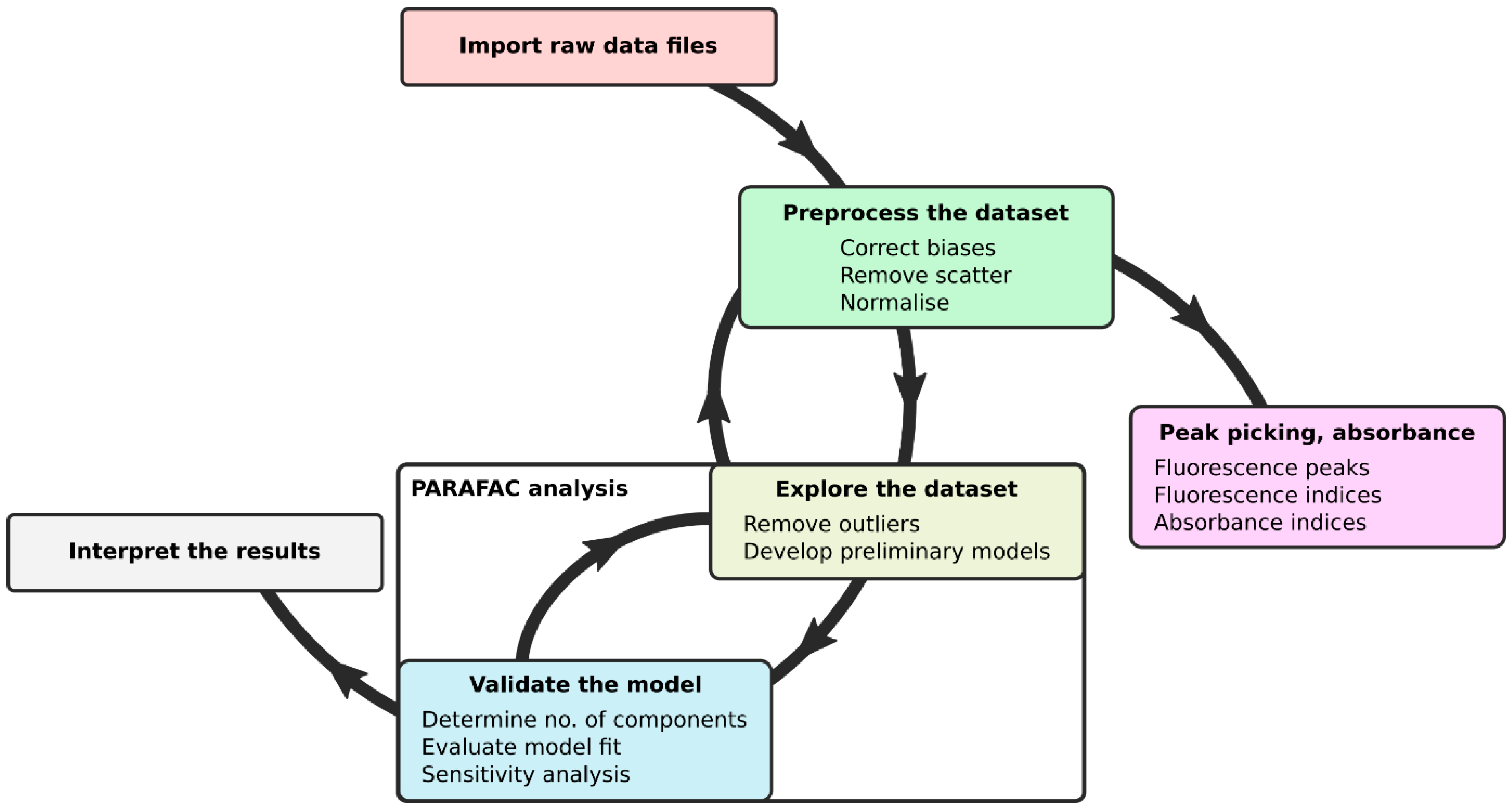

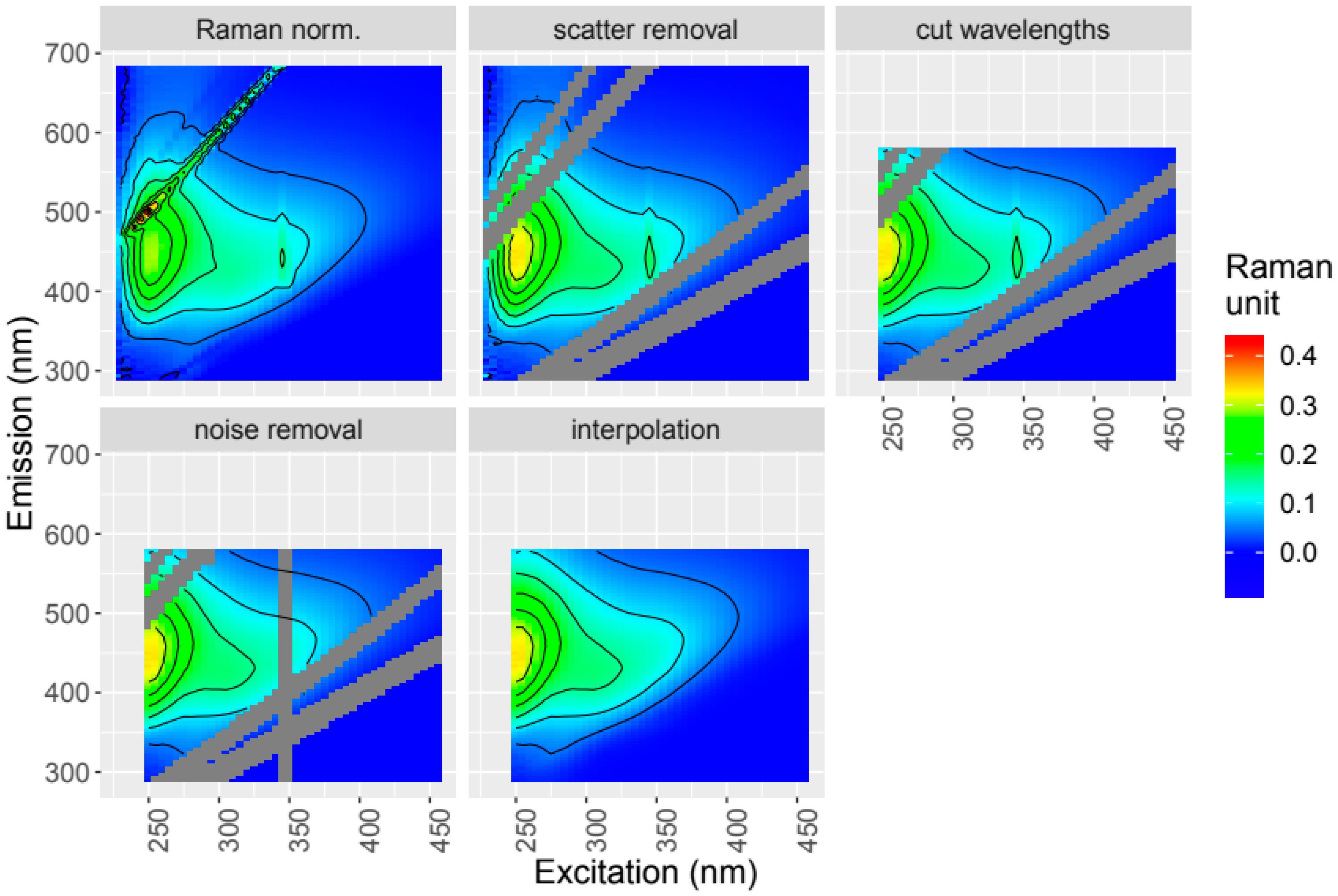
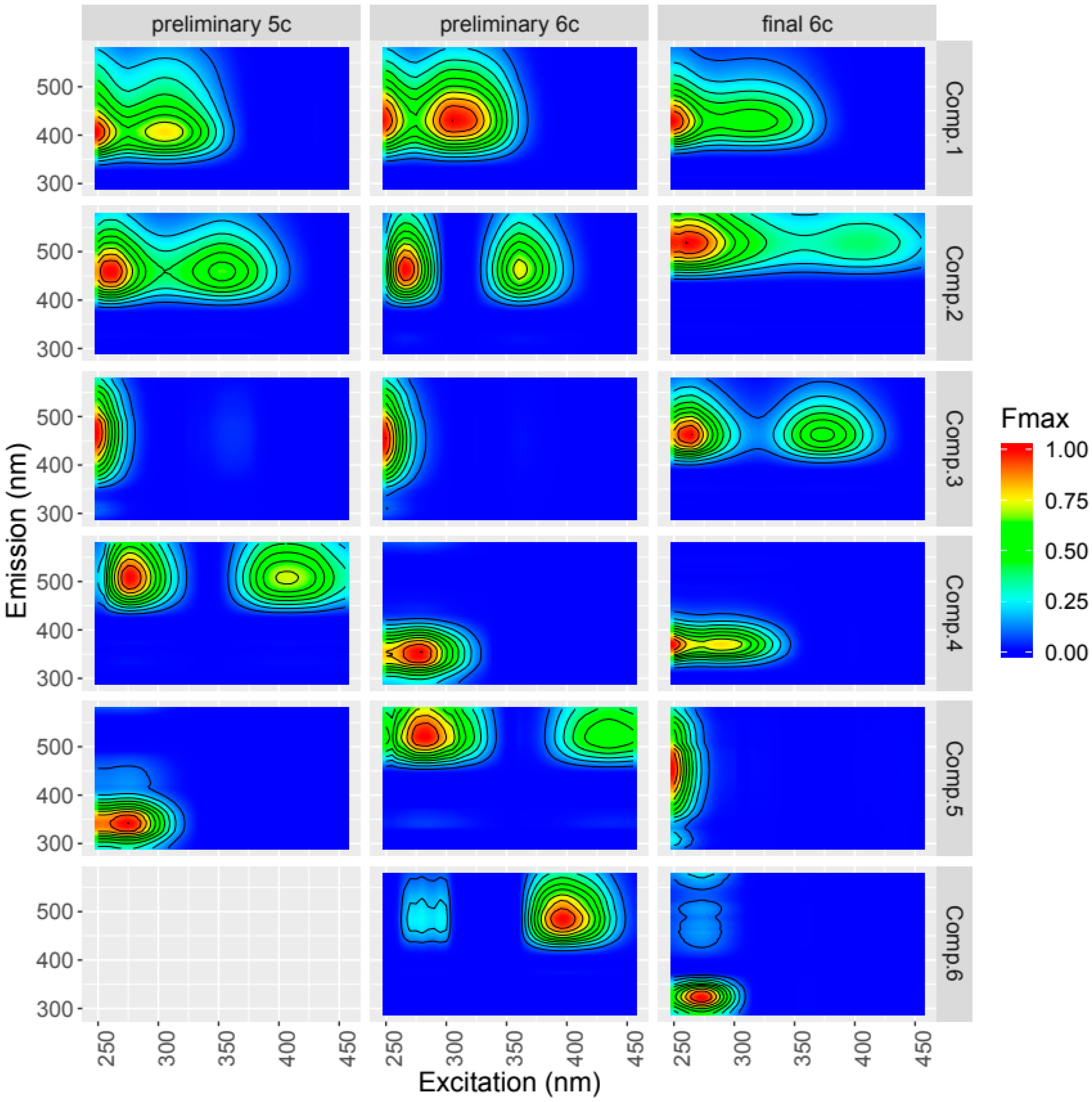
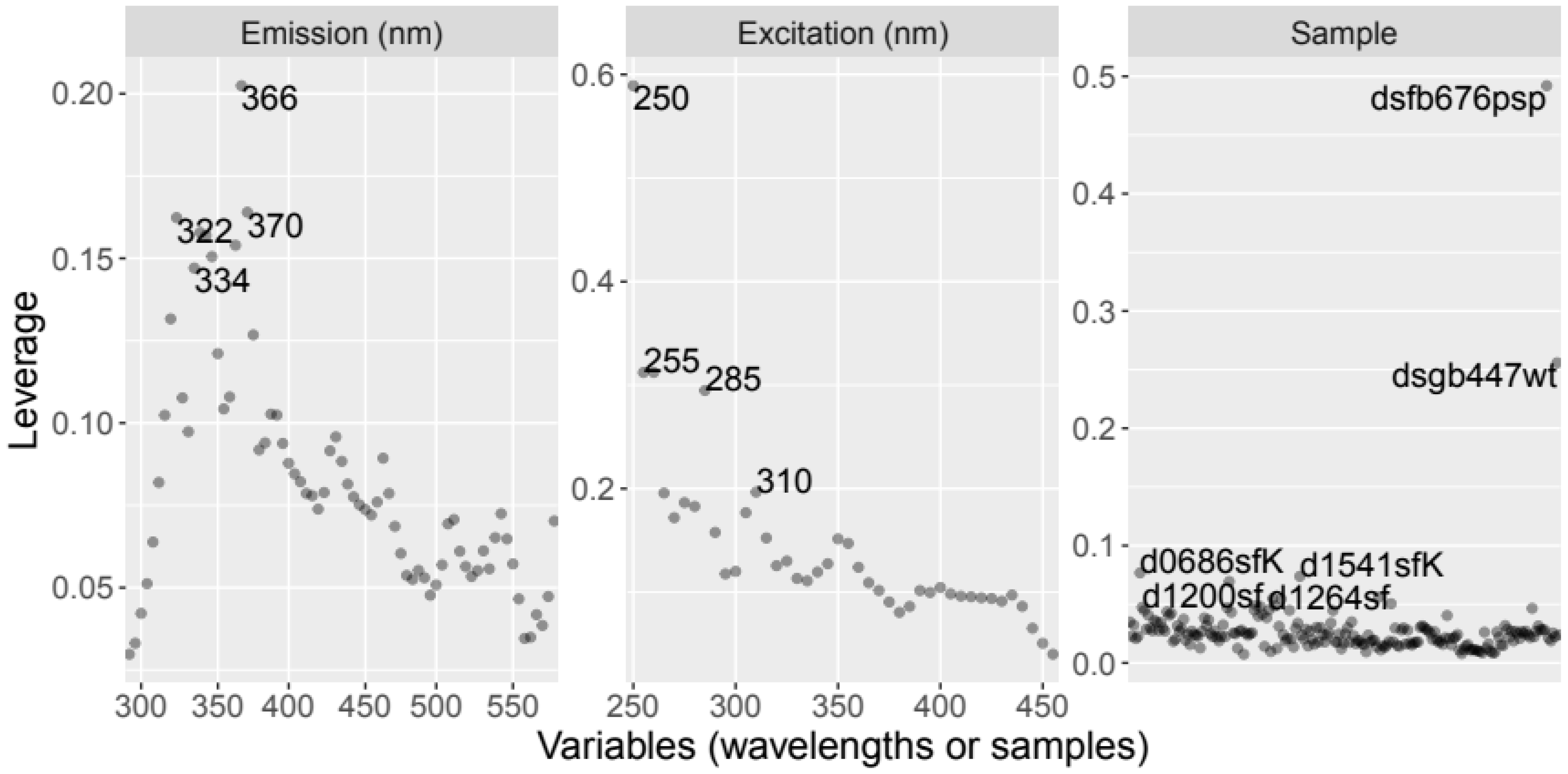



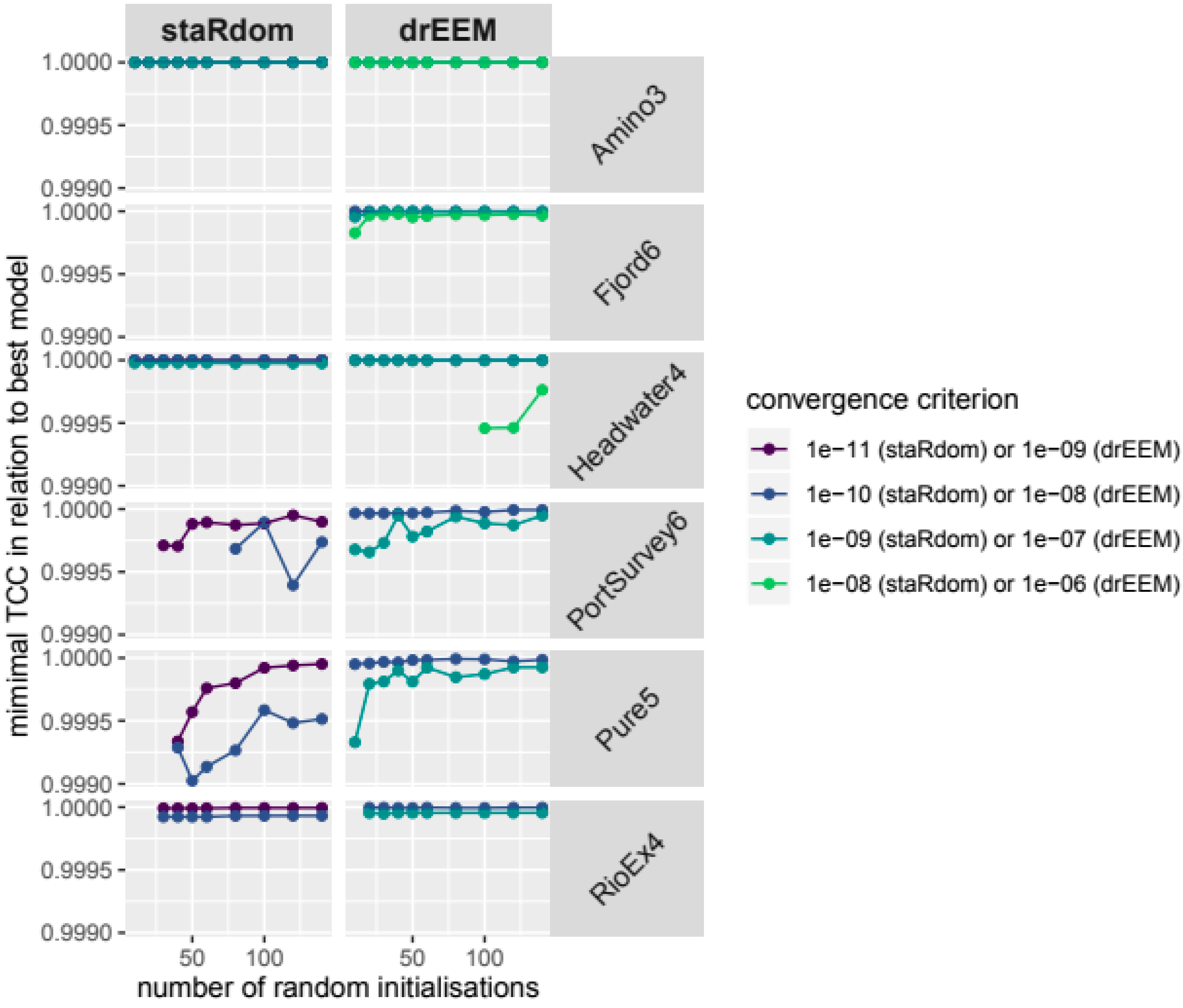
| Step of the Analysis | staRdom Functions Used | Purpose of the Function |
|---|---|---|
| import raw data | eem_read | load EEM data |
| absorbance_read | load absorbance data | |
| check data consistency | eem_checkdata | check presence and names of samples |
| view data | ggeem | create single plots |
| eem_overview plot | create multiple plots | |
| correct biases | abs_blcor | absorbance baseline correction |
| eem_spectral_cor | EEM spectral correction | |
| eem_remove_blank | subtract blank sample | |
| eem_ife_correction | inner-filter effect correction | |
| eem_raman_normalisation,eem_raman_normalisation2 | normalize EEM data to Raman units | |
| remove scatter | eem_rem_scat | remove Rayleigh and Raman scattering of 1st and 2nd order |
| eem_setNA | remove noise manually | |
| eem_interp | interpolate missing data | |
| synchronize sample wavelength | eem_red2smallest | remove all wavelengths that are not present in all samples |
| eem_extend2largest | create all wavelengths present in any sample in all samples | |
| correct for sample dilution | eem_dilution | multiply EEM data by a dilution factor |
| smooth data | eem_smooth | smooth EEM data |
| normalize | no dedicated function, argument normalise = TRUE in eem_parafac | normalize EEM data |
| fluorescence peaks and indices | eem_biological_index | calculate BIX |
| eem_coble_peaks | calculate Coble peaks | |
| eem_fluorescence_index | calculate FI | |
| eem_humification_index | calculate HIX | |
| absorbance indices | abs_parms | calculate absorbance indices, spectral slopes, and selected ratios |
| calculate PARAFAC model (preliminary and final) | eem_parafac | calculate PARAFAC models |
| view PARAFAC models | eempf_compare | compare PARAFAC models (with different numbers of components) visually |
| eempf_comp_load_plot | plot single PARAFAC models | |
| identify outliers | eempf_leverage | calculate the leverage of each sample and wavelength |
| eempf_leverage_plot | plot leverages | |
| eempf_leverage_ident | manually select samples in leverage plots | |
| remove outliers | eem_exclude | remove samples and wavelengths from the data set |
| evaluate model | eempf_convergence | extract convergence behavior of a model |
| eempf_cortable, eempf_corplot | show correlation between components | |
| eempf_corcondia | calculate the core consistency | |
| sensitivity analysis | splithalf, splithalf_plot | calculate and plot a split-half validation |
| interpret the results | eempf4analysis | export table with component loadings |
| eempf_report | create an analysis report in html format | |
| eempf_openfluor | export data for openfluor.org |
| Name | Number of | % | Description | Reference | |||
|---|---|---|---|---|---|---|---|
| Comps 1 | Samples | Em 2 | Ex 3 | NA 4 | |||
| Amino3 | 3 | 5 | 201 | 61 | 0 | Pure amino acids | [31] |
| Fjord6 | 6 | 191 | 91 | 44 | 16.6 | Solid-phase extracts of DOM from three arctic fjords | [68] |
| Headwater4 | 4 | 235 | 151 | 43 | 0 | Headwater streams, and agricultural catchments, Denmark and Uruguay | [20] |
| PortSurvey6 | 6 | 206 | 73 | 42 | 9.5 | port and oceanic marine samples (USA, Pacific coast), drEEM tutorial dataset | [54] |
| Pure5 | 5 | 60 | 50 | 40 | 0 | Pure substances with added artificial noise | unpublished |
| RioEx4 | 4 | 58 | 97 | 111 | 0 | Photodegradation experiment of solid-phase extracted DOM | [69] |
| Name | Software | Convergence Criterion | Initializations | Relative Error | Minimum TCC |
|---|---|---|---|---|---|
| Amino3 | staRdom | 1 × 10−8 | 10 | 1.000069 | 1.0000 |
| drEEM | 1 × 10−8 | 10 | 1.000000 | 1.0000 | |
| Headwater4 | staRdom | 1 × 10−9 | 10 | 1.000010 | 1.0000 |
| drEEM | 1 × 10−7 | 10 | 1.000002 | 1.0000 | |
| PortSurvey6 | staRdom | 1 × 10−11 | 30 | 1.000042 | 0.9997 |
| drEEM | 1 × 10−7 | 10 | 1.000039 | 0.9997 | |
| Pure5 | staRdom | 1 × 10−10 | 40 | 1.000071 | 0.9993 |
| drEEM | 1 × 10−7 | 10 | 1.000056 | 0.9993 | |
| RioEx4 | staRdom | 1 × 10−10 | 30 | 1.000022 | 0.9999 |
| drEEM | 1 × 10−7 | 20 | 1.000015 | 1.0000 |
© 2019 by the authors. Licensee MDPI, Basel, Switzerland. This article is an open access article distributed under the terms and conditions of the Creative Commons Attribution (CC BY) license (http://creativecommons.org/licenses/by/4.0/).
Share and Cite
Pucher, M.; Wünsch, U.; Weigelhofer, G.; Murphy, K.; Hein, T.; Graeber, D. staRdom: Versatile Software for Analyzing Spectroscopic Data of Dissolved Organic Matter in R. Water 2019, 11, 2366. https://doi.org/10.3390/w11112366
Pucher M, Wünsch U, Weigelhofer G, Murphy K, Hein T, Graeber D. staRdom: Versatile Software for Analyzing Spectroscopic Data of Dissolved Organic Matter in R. Water. 2019; 11(11):2366. https://doi.org/10.3390/w11112366
Chicago/Turabian StylePucher, Matthias, Urban Wünsch, Gabriele Weigelhofer, Kathleen Murphy, Thomas Hein, and Daniel Graeber. 2019. "staRdom: Versatile Software for Analyzing Spectroscopic Data of Dissolved Organic Matter in R" Water 11, no. 11: 2366. https://doi.org/10.3390/w11112366
APA StylePucher, M., Wünsch, U., Weigelhofer, G., Murphy, K., Hein, T., & Graeber, D. (2019). staRdom: Versatile Software for Analyzing Spectroscopic Data of Dissolved Organic Matter in R. Water, 11(11), 2366. https://doi.org/10.3390/w11112366







